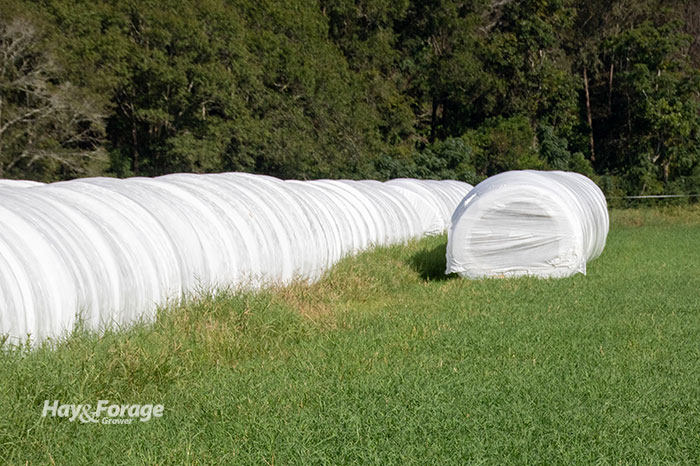
Bermudagrass is a staple species in many Southeastern hayfields. Even so, unpredictable rainfall patterns and extended periods of wet weather can make harvesting this warm-season grass a daunting task.
Making baleage is one way to reduce the risk of rain on dry hay. In fact, at the American Forage and Grassland Council’s Annual Conference last week in Mobile, Ala., Jennifer Tucker with the University of Georgia said baleage is a game changer in the Southeast. However, bermudagrass can’t win this game on its own.
“If you ask an economist, it does not pay to use bermudagrass for baleage production with the quality and tonnage you are going to get,” the extension beef and forage specialist said. “When we grow alfalfa with bermudagrass, things will pencil out if we put that mixed forage into baleage.”
Tucker explained that interseeding alfalfa into bermudagrass stands improves tonnage and lengthens the growing season, thus enhancing overall yield. For example, bermudagrass is most productive during the warmest months of the year, but alfalfa grows best in the spring and fall. Integrating the two species into one system would optimize the growth patterns of both forages.
Alfalfa-bermudagrass baleage can also be higher quality than pure bermudagrass baleage. Tucker noted elevated crude protein and total digestible nutrients from alfalfa reduces the need for supplementation during winter feeding, which also enhances farm profitability.
“This way, we don’t have to buy extra nutrients to meet animal needs. Alfalfa extends our land use, and it fills gaps in forage production,” Tucker said. “And if alfalfa doesn’t establish well or it dies out over time, you still have that bermudagrass base,” she added.
Red clover considerations
Despite the benefits of alfalfa in bermudagrass, Tucker said some producers are partial to clovers because they are easier to establish and maintain. Although species like crimson clover and arrowleaf clover are effective in boosting bermudagrass yields, she argued these annual legumes are not a long-term solution for better baleage.
Red clover, on the other hand, can have similar advantages as alfalfa in bermudagrass. Tucker conducted a study to compare the two legume options and found both mixes had similar yields and quality over the life of a stand. She noted that red clover can sometimes become competitive with bermudagrass and may shade it out over time. Nonetheless, it proves to be a viable option for baleage production.
The yield boost from alfalfa or red clover would lead to more harvests per year, which may not be attractive or feasible for some farmers. In this case, Tucker recommended implementing a dual-use approach to managing mixed stands by harvesting baleage in the spring and grazing forage in the fall.
Tucker noted alfalfa will be the dominant species for spring baleage production, and she suggested grazing cattle on ryegrass pastures or feeding baleage from the previous year during this time. Then, after allowing forage to rest through late summer, there should be adequate biomass to begin grazing mixed stands by September.
“Legume integration will pay off for producers,” Tucker concluded. “Baleage is something we need to be embracing as we continue to see varying weather patterns that make every year less predictable than the year before.”

